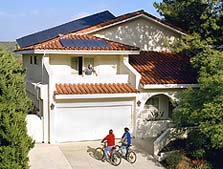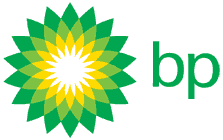

BP supplied many Solar Decathlon teams with photovoltaic panels, similar to those seen here.

Solar Decathlon 2005
Bringing Solar Into The Mainstream
Lee Edwards, CEO BP Solar
Not a week goes by that someone, somewhere in BP around the world is asked why we, one of the world's largest energy companies, is investing in renewable energies. This article aims to share how BP Solar approaches the renewables industry today, how we have transformed our own solar business over the last two years, and what we see as our priorities for future growth and success.
The BP renewables business is composed of several strands. Today, solar comprises one of the largest elements. BP is also active in wind energy, decarbonised fuel, co-generation, and hydrogen.
While each element is our strategy has unique potential, benefits, and growth, I would like to focus on solar. The main strategic driver of our growth is to make solar energy competitive with traditional 'on-grid' sources in material power markets. BP's goal is to bring solar into the mainstream of energy solutions — and while the continued growth is impressive, the real opportunity is just beginning.
The solar industry has made great progress so far. The market today is characterized by tremendous growth rates, a broad choice of products and technologies, profitability, new investments, continued innovation, and increased efficiencies. The solar sector is also attracting new people with new ideas to contribute to a healthy industry. Demand is currently ahead of supply, with the industry challenged to grow quickly while retaining high-quality products and improving the price per watt on installed costs.
Many in the industry, along with myself, are not satisfied we have done enough to capture the full potential of solar for the world. At BP, enabling solar to be a material component to the energy mix is a key objective.
So, what's our appetite as an industry for the pace of future growth and how will we get there? There are two important energy drivers of the future. Current oil and gas prices, security of supply, and environmental concerns are more important than ever. While these issues have been present for a while, the benefits of solar power have never been in more demand.
BP is working hard to provide leadership to resolve the energy paradox in meeting the world's increased need for energy and to enable human progress without limiting the long-term potential of future generations from environmental harm.
I have a few impressions of the solar industry that I think are worth noting:
The industry has to think big and bold: think gigawatts instead of megawatts: our plans might be courageous with goals that no doubt will be unreasonable to many.
Our installed costs per watt are too high: more efficient solutions across the entire value chain are needed. Perhaps more collaboration, more shared risks, and greater standardization can help.
We need to make it easier to satisfy our customers, in terms of access, product and installation quality, product design, and support.
Technology investments and innovation need to continue across the value chain. This is good for the industry but will increase risks for those who become complacent.
Solar manufacturing needs to be at global scale. At the same time, there has to be local industry to service local markets and meet local needs.
Policy makers need to create predictable and consistent market stimulation policies. Consistency will nurture this industry, but boom and bust may limit long-term health. And of course, we need this support to be widespread.
Actions to consider include creating a level playing field with simple and uniform net metering and interconnection standards, renewable energy credits, performance-based incentives, and "real-time-pricing" to allow the market to capture the real value of solar are all important policies that will help expand the market.
Turning to what we are doing in BP to bring solar into the mainstream, we must strive for the combination of sustainability and profitability.
The main driver of our business will be on-grid price parity in developed countries. In the United States, to expand market demand and simplify the solar offer to homeowners and businesses, we are offering BP Solar systems through The Home Depot in California, New Jersey, and Long Island. We also are part of a new partnership with Goldman Sachs and SunEdison, providing easy installations, quality systems, and financing for large commercial installations.
In response to growing demand for solar products in the United States and around the world, we are in the process of more than doubling manufacturing capacity by the end of 2006, including in the United States as we expand our Frederick, Maryland, plant.
We are also investing in future technology breakthroughs and innovations while at the same time supporting increased market awareness. BP Solar is once again proud to be the principal corporate sponsor of the 2005 Solar Decathlon.
The BP Solar Neighbors Program is another example helping expand awareness and demand. Every time a participating celebrity purchases a BP Solar Home SolutionTM, BP donates a full solar home system to a low-income family in Los Angeles, significantly reducing their electricity bills for years to come.
So, we in BP are committed to the success of solar. We are actively building the market, expanding production, investing in innovations for the future, and enhancing awareness of the benefits naturally provided by solar power. For me, they combine to create some of the most exciting elements of making solar mainstream.
